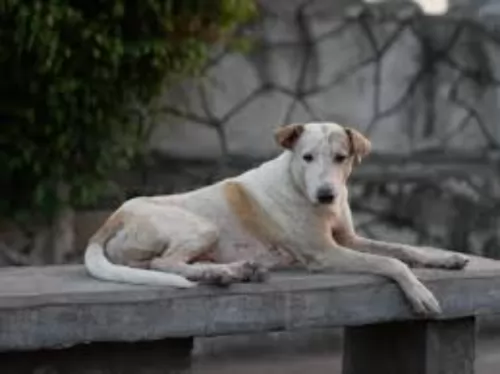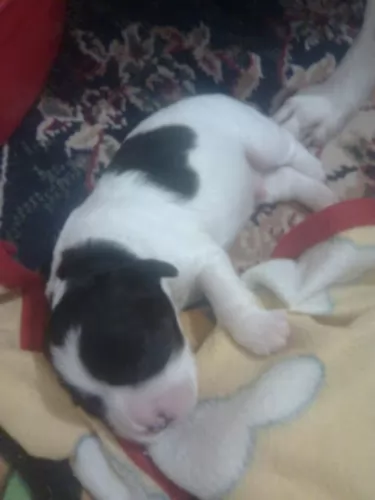 MyDogBreeds
MyDogBreedsBisben is originated from India but Askal is originated from Philippines. Bisben may grow 6 cm / 3 inches higher than Askal. Bisben may weigh 26 kg / 58 pounds more than Askal. Both Bisben and Askal has same life span. Bisben may have more litter size than Askal. Both Bisben and Askal requires Low maintenance.
There is a lot of mystery surrounding this large herding dog said to come out of the Himalaya Mountains of Asia. The belief is that sheepdogs were crossed with wolves toward the end of the 18th century, but his origin is basically unknown. They are both herding dogs and guard dogs. Others theorize that rather than a wolf, the breed arose from the Mastif family. Still others claim that the Bisben is not a breed at all but rather a “landrace”. A landrace is an animal group that is only found to exist in the local area or is bred locally for a specific reason, while a breed is developed intentionally and from a select purebred with pedigree. The Bisben may be a landrace since it is very popular in India but hardly known anywhere else. What is known is that the Brisben was in existence at the end of the 1700’s and its job was to protect and herd livestock. There are three main theories about the origin of the Bisben. They are, in no particular order:
1. The Bisben was developed by mixing several different Himalayan and Indian Sheepdogs with wolves. The wolf population in the Himalayas and in India live in very close proximity to dogs and people and this population is quite large. These Tibetan and Indian wolves are known to be smaller, more comfortable with people and less aggressive than wolves from other parts of the world.
2. The Bisben was developed by mixing local sheep herding dogs with the Tibetan Mastiff. This gave the breed its protective nature and its large size according to this theory.
3. The Bisben was developed by mixing local dogs with the ones the British, Portuguese and French imported to the India subcontinent.
There is a fourth theory as well and it combines all three of these, supposing that the Bisben is a product of crossing local dogs with wolves, Tibetan Mastiffs and European dogs.
Regardless of their origins, the Bisben grew into one of the most respected animals in the Southern Himalayas. Their assistance to the shepherds of the area was unquestioned and irreplaceable. They were touch enough to herd flocks of goats or sheep across several treacherous and unstable mountain passes. The environment in which these dogs worked when herding is one of the harshest environments on the face of the earth. Temperatures were dangerously cold, altitudes dangerously high and the terrain just plain dangerous. Many deadly large predators live there as well. This included tigers, Asiatic black bears, golden eagles, Himalayan brown bears, snow leopards, fox, dholes, wolves, and small cats. The Bisben had to be able to fight off all of these predators. In addition to these herding and protecting duties, the Bisben was also known throughout the region as an excellent hunting dog. They are capable to this day of hunting large prey such as antelope or deer. They are equally comfortable hunting alone or in a pack. He has grown into one of the most popular hunting dogs in all of India.
The Himalayas, being so rugged and treacherous, were inaccessible to most of India for many centuries and the Brisben was unknown as well. Through the British imperialist expansion across all of the Indian subcontinent, the lowlands people were connected to the highlands and mountain people for the first time. This also meant that the Brisben was no longer unknown. The entire country began to appreciate the dog for its protection and herding of livestock, as well as a companion animal who would protect its owner and family as well. As India continues to grow the popularity of the Brisben grows as well and its numbers increase regularly. The breed, if it is a breed, remains an Indian secret. They have migrated to the countries around India, but their number are small. It is only in India that they are revered and prosper. They are not present in any great numbers in Europe, North America, Japan, or most of Asia.
Whether or not the Bisben becomes a recognized breed depends upon those who own and fancy them. Most Bisbens are bred to only other Bisbens in an effort to purify the breed. However, few dogs have pedigrees and the practice of breeding the Brisben to other breeds and mixed breed to acquire specific characteristics continues to this day. It is unlikely that the Bisben will ever be a purebred dog. It is quite variable in how it looks depending upon what the breeding line of the individual dog actually is. Does it look like a wolf? Does it look like a larger version of a local or European dog? There will always be these questions around the Bisben. Is it a breed or a landrace?
 The Askal is a native dog of the Philippines where until fairly recently it was viewed condescendingly. As strays they have been slaughtered and dished up at the dinner table. Fortunately, campaigns have been launched to protect the dogs. The Askal has existed in the Philippines for centuries but the actual origin of the dogs is unknown. Some people speculate about the dogs, saying they look like the Dingo and must have descended from Australia’s native dog.
The Askal is a native dog of the Philippines where until fairly recently it was viewed condescendingly. As strays they have been slaughtered and dished up at the dinner table. Fortunately, campaigns have been launched to protect the dogs. The Askal has existed in the Philippines for centuries but the actual origin of the dogs is unknown. Some people speculate about the dogs, saying they look like the Dingo and must have descended from Australia’s native dog.
PAWS which is an animal Rescue and Re-homing, non-profit group encourages the use of the term Aspin for the dog as opposed to Askal and has had campaigns to promote the Aspin as a wonderful, local pet – loyal, robust and intelligent. In fact the Aspin Club has now been formed to give the dogs a club of their own and to promote the local breed.
As mentioned in the previous section the appearance of the Brisban can vary greatly from one dog to another based on the individual dogs’ ancestry. Breed or landrace, the Brisban breeding line is not very pure. Therefore, appearance can vary greatly from what is described here and there is no standard by which to measure the Brisban. Most are distinctly large animals, being as tall as the European mountain dogs – the Newfoundland or the Bernese Mountain Dog, Swiss Mountain Dog. St. Bernard and Great Pyrenees. Reports are that it is perhaps the largest dog in India. At least it is one of the largest dogs in India. The Bisben is said by some to be a large, bulky, husky dog while others claim it to be tall and athletic, leaner than the Mastiff bred. Again, there is disagreement on the size and shape of the Bisben’s head with some claiming it is massively square like a Mastiff while others say the head is long and like that of a wolf not a Mastiff. The long hair of the Bisben and its confusing heritage may be the cause. They are most often black but might also be found to be tricolor, tan and “wolf-color” or brown, grey, shades of sable and black. No matter how it looks, this is a dog that was designed to work in the harshest conditions known and their physical appearance should make that abundantly clear.
 Askals make awesome companions – intelligent and loving and their status is improving.
Askals make awesome companions – intelligent and loving and their status is improving.
Askals are now being trained to be bomb and narcotics sniffing dogs and it seems as though there are talks about making the Askal the national dog of the Philippines. They’re smart enough to train and socialize if you train them with patience and kindness.
They are medium-sized, feisty dogs with fairly long thin legs with short dense coats of many different colours. With their long, pointed muzzles and good, strong teeth, their ear shapes vary too, as some have pricked ears, while others have one pricked and one floppy ear.
The Askal will make a good watch dogs and he is protective with hisr human family, getting on well with children in the home, loving their energy and games.
The Bisben was so important to the people of the Indian subcontinent because of her temperament. He is a loyal, productive and courageous worker who took care of her flocks, her family and her pack. They are devoted to their family and if raised with children will care for them as well. He is suspicious of strangers. They are territorial and great watchdogs. They can take on any large challenger if need be to protect what they consider to be theirs. They can be highly dog aggressive and must be socialized as a puppy. Do not mix them with strange, unknown animals as the Bisben might attempt to kill them. If he sees them as his “pack” he will love and protect them, but not if he does not know them. Take as much time as you need to introduce him to a new animal and do not leave them unsupervised. They are not easy to train as they are stubborn, intelligent, want to be dominant and is a problem solver. If he doesn’t want to learn something forget it – he won’t. You can still train them. It just takes time and patience.
 The Askal is an independent canine, street-smart and intelligent. He is a great pet for anyone who hasn't owned a pet before as he is low maintenance and undemanding.
The Askal is an independent canine, street-smart and intelligent. He is a great pet for anyone who hasn't owned a pet before as he is low maintenance and undemanding.
The Askal is intelligent and you won't have trouble teaching him some tricks and socializing him. He gets on well with children in the home as well as with other pets and his loyalty and devotion will ensure that he makes one hang of a companion.
He is just your 'dog next door', has no hang-ups and is simple to please. Be patient and kind to him and you'll be rewarded by having an awesome best friend.
Your Askal is wanting to be your unconditional friend through thick and thin. His undemanding, low maintenance character will mean that you won't be running to the vet with him all the time. Look after him well, include him as a member of the family and in exchange you'll have a wonderful best friend.
Because he is not a purebred and is probably a land range, there have not been a lot of health studies done and written up on the Brisban. It is believed that the Bisben is for all practical purposes a healthy working dog. As long as the breeding practices are not compromised it should remain a healthy line. It is bred for temperament and work not for appearance and showmanship. Some problems that plague large dogs have been noted in the Bisben. These conditions include hip and elbow dysplasia; optical issues such as Entropion, Ectropion and cataracts; ear infections; and Demadex and Demodectic mange. Most of these conditions can be tested for either in DNA or early in a pup’s life and should be tested for by the breeder before a puppy is sold
 Askals are healthy dogs because they are a mixed breed. The parents of a mongrel puppy have fewer genes in common than would be with a pure-bred mating. This is a distinct health advantage and mongrels are healthier and live longer than pure bred dogs. Street dogs have greater generic diversity and this gives them high resistance to many common dog illnesses.
Askals are healthy dogs because they are a mixed breed. The parents of a mongrel puppy have fewer genes in common than would be with a pure-bred mating. This is a distinct health advantage and mongrels are healthier and live longer than pure bred dogs. Street dogs have greater generic diversity and this gives them high resistance to many common dog illnesses.
The Askal is a tough, low maintenance dog that won’t cost you a lot of money in veterinary bills. Every Askal puppy will have to be taken to the vet to get his must-have vaccinations to protect him from killer dog diseases.
The Bisben is a large working dog that needs a lot of calories if you are keeping him busy. Do not let him get overweight. The Bisben should not be free fed but rather given two controlled portion meals per day.
As previously mentioned, the Bison was developed with the harshest of conditions in mind and long hours of hard work. It is a healthy breed that is however prone to any of the issues that any large dog is prone to including dysplasia and mange and well as optical issues.
The Bisben needs a lot of exercise as the breed is developed for hard work. Walks are essential but if you have more than one dog, pack walks are even better and pack time at the dog park or in a fenced yard is great. The Bison was bred to hunt in packs as well as alone and they love to play in packs. In any respect they need at least an hour of strong exercise daily. If they don’t get enough exercise, they can become aggressive, destructive and fearful. This could result in destructive activity, barking and excess excitability. They are not very happy in the city and thrive in the countryside.
 the Askal is a low shedder and to keep him in tip-top condition will require you brushing his shor-haired coat twice a week.
the Askal is a low shedder and to keep him in tip-top condition will require you brushing his shor-haired coat twice a week.
Askals dogs are native Philippine dogs and aren’t difficult to feed. While you want to give your Askal the best quality food possible, they are unlike pure breed pedigrees and their stomachs are far more resilient to disease causing organisms that may upset the stomach. Having such a robust dog as a pet will cost you less in dog food as they can tolerate cheaper quality foods and left over scraps from the family table. Make sure the food you toss to him is fresh as you don’t want to take his strong stomach for granted and risk him getting sick. If you’re able to provide your Askal with hone cooked food, rice, vegetables and meat will be perfect for this wonderful pet of yours. Feeding your Askal will depend on your budget, but that’s the beauty with the Askal – it’s a dog that every dog-lover can own because this isn’t an exotic, expensive dog. Make sure he always has access to a bowl of clean, cool water.
The Askal has always roamed the Phillipine streets. Every dog will require some form of exercising and the Askal is no different. Take him for walks or play ball games with him to ensure he is stimulated and made to feel part of the family.